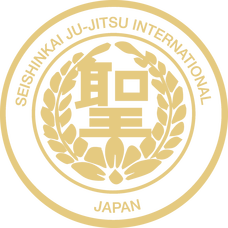also known as the Akō incident, is an 18th-century historical event in Japan in which a band of Rōnin (leaderless Samurai) avenged the death of their master. The incident has since become legendary.
In 1701, two Daimyō, Asano Takumi-no-Kami Naganori, the young Daimyō of the Akō Domain (a small fiefdom in western Honshū), and Lord Kamei Korechika of the Tsuwano Domain, were ordered to arrange a fitting reception for the envoys of Emperor Higashiyama at Edo Castle, during their Sankin-kōtai service to the Shōgun.
Asano and Kamei were to be given instruction in the necessary court etiquette by Kira Kozuke-no-Suke Yoshinaka, a powerful official in the hierarchy of Tokugawa Tsunayoshi’s Shogunate. He allegedly became upset at them, either because of the insufficient presents they offered him (in the time-honored compensation for such an instructor), or because they would not offer bribes as he wanted. Other sources say that he was naturally rude and arrogant or that he was corrupt, which offended Asano, a devoutly moral Confucian.
By some accounts, it also appears that Asano may have been unfamiliar with the intricacies of the Shogunate court and failed to show the proper amount of deference to Kira. Whether Kira treated them poorly, insulted them, or failed to prepare them for fulfilling specific bakufu duties, offence was taken.
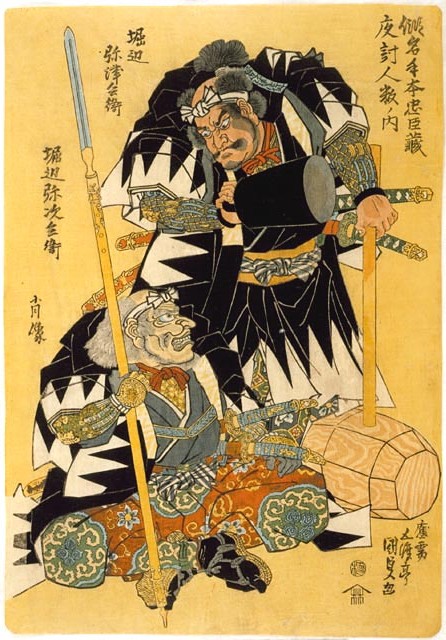
Initially, Asano bore all this stoically, while Kamei became enraged and prepared to kill Kira to avenge the insults. However, Kamei’s quick-thinking counselors averted disaster for their lord and clan (for all would have been punished if Kamei had killed Kira) by quietly giving Kira a large bribe; Kira thereupon began to treat Kamei nicely, which calmed Kamei.
However, Kira allegedly continued to treat Asano harshly because he was upset that the latter had not emulated his companion. Finally, Kira insulted Asano, calling him a country boor with no manners, and Asano could restrain himself no longer. At the Matsu no Ōrōka, the main grand corridor that interconnects the Shiro-shoin (白書院) and the Ōhiroma of the Honmaru Goten (本丸御殿) residence, Asano lost his temper and attacked Kira with a dagger, wounding him in the face with his first strike; his second missed and hit a pillar. Guards then quickly separated them.
Kira’s wound was hardly serious, but the attack on a shogunate official within the boundaries of the shōgun’s residence was considered a grave offence. Any kind of violence, even the drawing of a katana, was completely forbidden in Edo Castle.
The daimyō of Akō had removed his dagger from its scabbard within Edo Castle, and for that offence, he was ordered to kill himself by Seppuku. Asano’s goods and lands were to be confiscated after his death, his family was to be ruined, and his retainers were to be made rōnin (leaderless).
This news was carried to Ōishi Kuranosuke Yoshio, Asano’s principal counsellor, who took command and moved the Asano family away before complying with bakufu orders to surrender the castle to the agents of the government.
REVANGE PLOT
Of Asano’s over 300 men, 47, especially their leader Ōishi, refused to allow their lord to go unavenged, even though revenge had been prohibited in the case.
They banded together, swearing a secret oath to avenge their master by killing Kira, even though they knew that they would be severely punished for doing so.
Kira was well guarded, however, and his residence had been fortified to prevent just such an event. The Rōnin saw that they would have to lull the suspicions of Kira and other Shogunate authorities, so they dispersed and became tradesmen and monks.
Ōishi took up residence in Kyoto and began to frequent brothels and taverns, as if nothing were further from his mind than revenge. Kira still feared a trap and sent spies to watch Asano’s former retainers.
One day, as Ōishi was returning home drunk, he fell down in the street and went to sleep, and all the passers-by laughed at him.
A Satsuma man was so infuriated by this behaviour on the part of a samurai—by his lack of courage to avenge his master as well as his current debauched behaviour—that he abused and insulted Ōishi, kicking him in the face (to even touch the face of a samurai was a great insult, let alone strike it) and spitting on him.
Not too long after, Ōishi divorced his loyal wife of twenty years so that no harm would come to her when the Rōnin took their revenge. He sent her away with their two younger children to live with her parents; he gave their eldest boy, Chikara, the choice to stay and fight or to leave. Chikara remained with his father.
Ōishi began to act oddly and very unlike the composed Samurai. He frequented Geisha houses (particularly Ichiriki Chaya), drank nightly, and acted obscenely in public.
Ōishi’s men bought a Geisha, hoping she would calm him. This was all a ruse to rid Ōishi of his spies.
Kira’s agents reported all this to Kira, who became convinced that he was safe from Asano’s retainers, that they must all be bad samurai indeed, without the courage to avenge their master after a year and a half. Thinking them harmless and lacking funds from his “retirement”, he then reluctantly let down his guard.
The rest of the faithful rōnin now gathered in Edo, and in their roles as workmen and merchants gained access to Kira’s house, becoming familiar with the layout of the house and the character of all within. One of the retainers (Okano Kinemon Kanehide) went so far as to marry the daughter of the builder of the house, to obtain the house’s design plans. All of this was reported to Ōishi. Others gathered arms and secretly transported them to Edo, another offence.
ATTACK
After two years, when Ōishi was convinced that Kira was thoroughly off his guard, and everything was ready, he fled from Kyoto, avoiding the spies who were watching him, and the entire band gathered at a secret meeting place in Edo to renew their oaths.
In Genroku 15, (1702) 14 December (元禄十五年十二月十四日), early in the morning in a driving wind during a heavy fall of snow, Ōishi and the other Rōnin attacked Kira Yoshinaka’s mansion in Edo. According to a carefully laid-out plan, they split up into two groups and attacked, armed with swords and bows. One group, led by Ōishi, was to attack the front gate; the other, led by his son, Ōishi Chikara, was to attack the house via the back gate. A drum would sound the simultaneous attack, and a whistle would signal that Kira was dead.
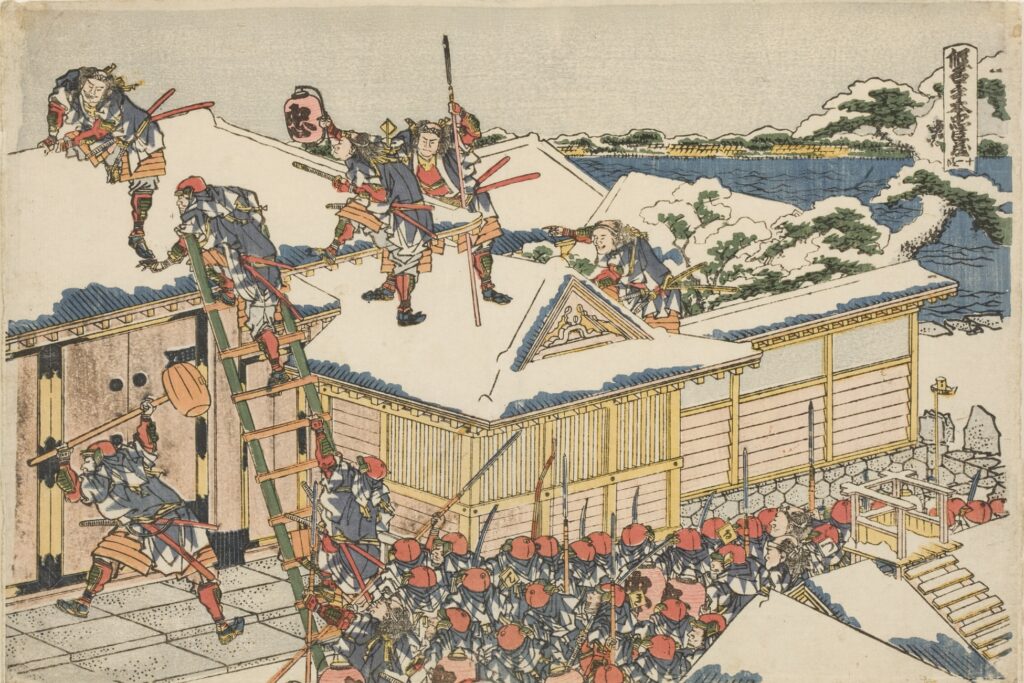
Once Kira was dead, they planned to cut off his head and lay it as an offering on their master’s tomb. They would then turn themselves in and wait for their expected sentence of death. All this had been confirmed at a final dinner, at which Ōishi had asked them to be careful and spare women, children, and other helpless people.
Ōishi had four men scale the fence and enter the porter’s lodge, capturing and tying up the guard there. He then sent messengers to all the neighboring houses, to explain that they were not robbers but retainers out to avenge the death of their master, and that no harm would come to anyone else: the neighbors were all safe. One of the rōnin climbed to the roof and loudly announced to the neighbors that the matter was an act of revenge (Katakiuchi, 敵討ち). The neighbors, who all hated Kira, were relieved and did nothing to hinder the raiders.
After posting archers (some on the roof) to prevent those in the house (who had not yet awakened) from sending for help, Ōishi sounded the drum to start the attack. Ten of Kira’s retainers held off the party attacking the house from the front, but Ōishi Chikara’s party broke into the back of the house.
Kira, in terror, took refuge in a closet in the veranda, along with his wife and female servants. The rest of his retainers, who slept in barracks outside, attempted to come into the house to his rescue. After overcoming the defenders at the front of the house, the two parties led by father and son joined up and fought the retainers who came in. The latter, perceiving that they were losing, tried to send for help, but their messengers were killed by the archers posted to prevent that eventuality.
Eventually, after a fierce struggle, the last of Kira’s retainers were subdued; in the process, the Rōnin killed 16 of Kira’s men and wounded 22, including his grandson. Of Kira, however, there was no sign. They searched the house, but all they found were crying women and children. They began to despair, but Ōishi checked Kira’s bed, and it was still warm, so he knew he could not be far away.
DEATH OF KIRA
A renewed search disclosed an entrance to a secret courtyard hidden behind a large scroll; the courtyard held a small building for storing charcoal and firewood, where two more hidden armed retainers were overcome and killed. A search of the building disclosed a man hiding; he attacked the searcher with a dagger, but the man was easily disarmed.
He refused to say who he was, but the searchers felt sure it was Kira, and sounded the whistle. The Rōnin gathered, and Ōishi, with a lantern, saw that it was indeed Kira—as a final proof, his head bore the scar from Asano’s attack.
Ōishi went on his knees, and in consideration of Kira’s high rank, respectfully addressed him, telling him they were retainers of Asano, come to avenge him as true samurai should, and inviting Kira to die as a true samurai should, by killing himself. Ōishi indicated he personally would act as a kaishakunin (“second”, the one who beheads a person committing seppuku to spare them the indignity of a lingering death) and offered him the same dagger that Asano had used to kill himself.
However, no matter how much they entreated him, Kira crouched, speechless and trembling. At last, seeing it was useless to continue asking, Ōishi ordered the other Rōnin to pin him down and killed him by cutting off his head with the dagger. They then extinguished all the lamps and fires in the house (lest any cause the house to catch fire and start a general fire that would harm the neighbors) and left, taking Kira’s head.
One of the Rōnin, the Ashigaru Terasaka Kichiemon, was ordered to travel to Akō and report that their revenge had been completed. (Though Kichiemon’s role as a messenger is the most widely accepted version of the story, other accounts have him running away before or after the battle, or being ordered to leave before the rōnin turned themselves in.)
AFTERMATH
As day was breaking, they quickly carried Kira’s head from his residence to their lord’s grave in Sengaku-ji temple, marching about ten kilometers across the city, causing a great stir on the way. The story of the revenge spread quickly, and everyone on their path praised them and offered them refreshment.
On arriving at the temple, the remaining 46 Rōnin (all except Terasaka Kichiemon) washed and cleaned Kira’s head in a well, and laid it, and the fateful dagger, before Asano’s tomb.
They then offered prayers at the temple and gave the abbot of the temple all of the money they had left, asking him to bury them decently and offer prayers for them.
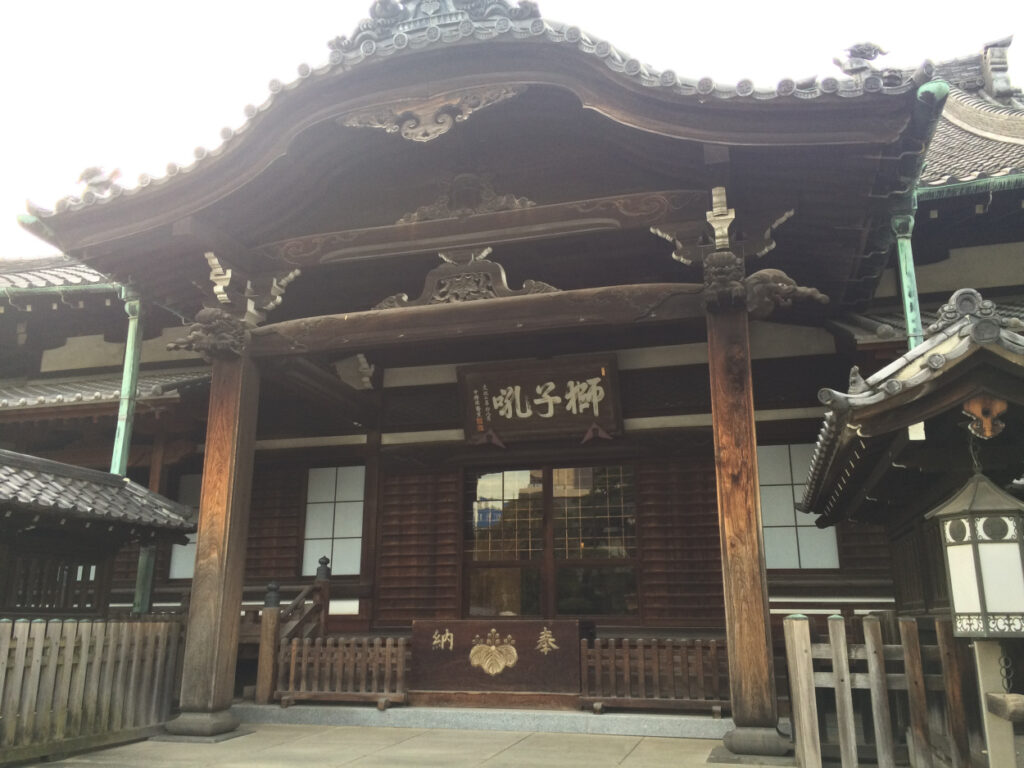
They then turned themselves in; the group was broken into four parts and put under guard of four different daimyō. During this time, two of Kira’s friends came to collect his head for burial; the temple still has the original receipt for the head, which the friends and the priests who dealt with them had all signed.
The Shogunate officials in Edo were in a quandary. The Samurai had followed the precepts by avenging the death of their lord; but they had also defied the shogunate’s authority by exacting revenge, which had been prohibited. In addition, the shōgun received a number of petitions from the admiring populace on behalf of the rōnin.
As expected, the Rōnin were sentenced to death for the murder of Kira; but the Shōgun finally resolved the quandary by ordering them to honorably commit seppuku instead of having them executed as criminals.
Each of the assailants ended his life in a ritualistic fashion. Ōishi Chikara, the youngest, was only 15 years old on the day the raid took place, and only 16 the day he committed seppuku.
Each of the 46 Rōnin killed himself in Genroku 16, on the 4th day of the 2nd month (元禄十六年二月四日, February 4, 1703).
This has caused a considerable amount of confusion ever since, with some people referring to the “forty-six rōnin”; this refers to the group put to death by the Shōgun, while the actual attack party numbered forty-seven.
The forty-seventh rōnin, identified as Terasaka Kichiemon, eventually returned from his mission and was pardoned by the Shōgun (some say on account of his youth).
He lived until the age of 87, dying around 1747, and was then buried with his comrades. The assailants who died by Seppuku were subsequently interred on the grounds of Sengaku-ji, nowadays Tokyo in front of the tomb of their master.
The clothes and arms they wore are still preserved in the temple to this day, along with the drum and whistle; their armor was all home-made, as they had not wanted to arouse suspicion by purchasing any.
The tombs at Sengaku-ji became a place of great veneration, and people flocked there to pray. The graves at the temple have been visited by a great many people throughout the years since the Genroku era. One of those was the Satsuma man who had mocked and spat on Ōishi as he lay drunk in the street. Addressing the grave, he begged for forgiveness for his actions and for thinking that Ōishi was not a true Samurai. He then committed suicide and was buried next to the Rōnin.
RE-ESTABLISHEMENT OF THE ASANO CLAN’S LORDSHIP
Though the revenge is often viewed as an act of loyalty, there had been a second goal, to re-establish the Asanos’ lordship and find a place for their fellow Samurai to serve. Hundreds of samurai who had served under Asano had been left jobless, and many were unable to find employment, as they had served under a disgraced family. Many lived as farmers or did simple handicrafts to make ends meet. The revenge of the forty-seven rōnin cleared their names, and many of the unemployed samurai found jobs soon after the rōnin had been sentenced to their honorable end.
Asano Daigaku Nagahiro, Naganori’s younger brother and heir, was allowed by the Tokugawa Shogunate to re-establish his name, though his territory was reduced to a tenth of the original.
Below are THE NAMES OF THE 47 RONIN in the following form: family name – pseudonym (Kemyō) – real name (Imina).
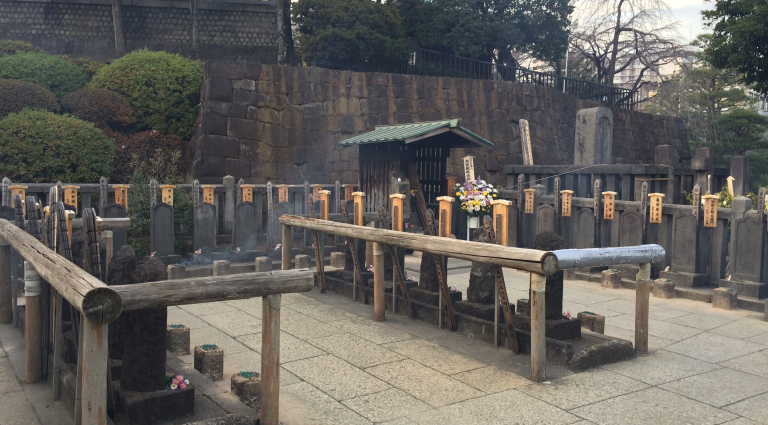
1 – Ōishi Kuranosuke Yoshio/Yoshitaka (大石 内蔵助 良雄)
2 – Ōishi Chikara Yoshikane (大石 主税 良金)
3 – Hara Sōemon Mototoki (原 惣右衛門 元辰)
4 – Kataoka Gengoemon Takafusa (片岡 源五右衛門 高房)
5 – Horibe Yahei Kanamaru/Akizane (堀部 弥兵衛 金丸)
6 – Horibe Yasubei Taketsune (堀部 安兵衛 武庸)
7 – Yoshida Chūzaemon Kanesuke (吉田 忠左衛門 兼亮)
8 – Yoshida Sawaemon Kanesada (吉田 沢右衛門 兼貞)
9 – Chikamatsu Kanroku Yukishige (近松 勘六 行重)
10- Mase Kyūdayū Masaaki (間瀬 久太夫 正明)
11- Mase Magokurō Masatoki (間瀬 孫九郎 正辰)
12- Akabane Genzō Shigekata (赤埴 源蔵 重賢)
13- Ushioda Matanojō Takanori (潮田 又之丞 高教)
14- Tominomori Sukeemon Masayori (富森 助右衛門 正因)
15- Fuwa Kazuemon Masatane (不破 数右衛門 正種)
16- Okano Kin’emon Kanehide (岡野 金右衛門 包秀)
17- Onodera Jūnai Hidekazu (小野寺 十内 秀和)
18- Onodera Kōemon Hidetomi (小野寺 幸右衛門 秀富)
19- Kimura Okaemon Sadayuki (木村 岡右衛門 貞行)
20- Okuda Magodayū Shigemori (奥田 孫太夫 重盛)
21- Okuda Sadaemon Yukitaka (奥田 貞右衛門 行高)
22- Hayami Tōzaemon Mitsutaka (早水 藤左衛門 満尭)
23- Yada Gorōemon Suketake (矢田 五郎右衛門 助武)
24- Ōishi Sezaemon Nobukiyo (大石 瀬左衛門 信清)
25- Isogai Jūrōzaemon Masahisa (礒貝 十郎左衛門 正久)
26- Hazama Kihei Mitsunobu (間 喜兵衛 光延)
27- Hazama Jūjirō Mitsuoki (間 十次郎 光興)
28- Hazama Shinrokurō Mitsukaze (間 新六郎 光風)
29- Nakamura Kansuke Masatoki (中村 勘助 正辰)
30- Senba Saburobei Mitsutada (千馬 三郎兵衛 光忠)
31- Sugaya Hannojō Masatoshi (菅谷 半之丞 政利)
32- Muramatsu Kihei Hidenao (村松 喜兵衛 秀直)
33- Muramatsu Sandayū Takanao (村松 三太夫 高直)
34- Kurahashi Densuke Takeyuki (倉橋 伝助 武幸)
35- Okajima Yasoemon Tsuneshige (岡島 八十右衛門 常樹)
36- Ōtaka Gengo Tadao/Tadatake (大高 源五 忠雄)
37- Yatō Emoshichi Norikane (矢頭 右衛門七 教兼)
38- Katsuta Shinzaemon Taketaka (勝田 新左衛門 武尭)
39- Takebayashi Tadashichi Takashige (武林 唯七 隆重)
40- Maebara Isuke Munefusa (前原 伊助 宗房)
41- Kaiga Yazaemon Tomonobu (貝賀 弥左衛門 友信)
42- Sugino Jūheiji Tsugifusa (杉野 十平次 次房)
43- Kanzaki Yogorō Noriyasu (神崎 与五郎 則休)
44- Mimura Jirōzaemon Kanetsune (三村 次郎左衛門 包常)
45- Yakokawa Kanbei Munetoshi (横川 勘平 宗利)
46- Kayano Wasuke Tsunenari (茅野 和助 常成)
47- Terasaka Kichiemon Nobuyuki(寺坂 吉右衛門 信行)
